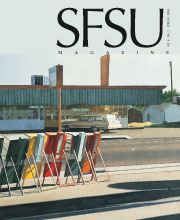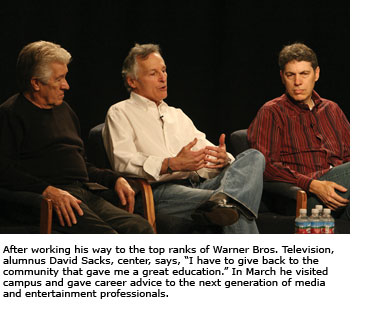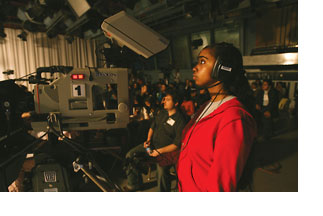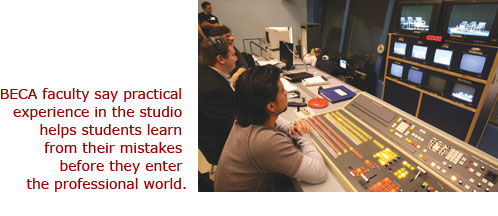 |
| |||
This Just In: BECA Turns 60 As an SF State undergraduate, Anita Pepper (B.A., '96) took to heart the advice of visiting media professionals: Be willing to accept any job to break into the industry. After graduation, she started with the tedious task of logging videotapes at MSNBC's San Francisco studio. She took another entry-level job, as a production assistant, and worked as an associate producer on several programs before joining the staff of "Dr. Phil" and becoming a show producer for the top-rated program. Pepper is one of countless alumni inspired by the career-focused panels that are a longtime tradition in the Broadcast and Electronic Communication Arts (BECA) Department. Many alumni return years after graduation to speak to students about their careers.
The BECA department has attained its eminence largely through the success of its graduates. Alumni work in most every area in the industry, from the serious journalism of CNN Headline News anchor Mike Galanos (B.A., '86) and ABC 7 anchor Cheryl Jennings (attended '70s) to the comedy of former "Saturday Night Live" cast member Dana Carvey (B.A., '79) and script writer David Pollock (B.A., '62) ("The Mary Tyler Moore Show," "M*A*S*H," "Bad Boys" and "Toy Story 2"). As the department has grown, so has the respectability for radio and television, both as career options and academic fields. "When I attended SF State, the department was there, but was a world unto itself," Pollock says. "[People would often say], âWhat, you're going to write jokes for a living?' Now [faculty] teach sitcom and comedy writing at the Ivy League schools." Malou Nubla (B.A., '91), who won two Northern California Emmys as cohost of CBS 5's "Evening Magazine," overcame her initial fear of being on the air when a class assignment placed her in front of a news camera. "If I hadn't been shoved out there ⦠I wouldn't be where I am today," says Nubla, who was also cohost of the same channel's "Eye on the Bay." Ted Griggs (B.A., '84), vice president of programming and operations at Fox Sports Net Bay Area and winner of multiple Northern California Emmys, says he "had a blast" as news director and anchor for the student-produced KSFS television news. His experience helped him land his first job before he graduated, as a sports producer for KRON-4, San Francisco's NBC affiliate at the time. Perhaps no student went farther afield than Peter Finch (B.A., '81). As a sophomore, he landed a DJ job at a Monterey radio station. On Saturday mornings, Finch would fly to Monterey for his Saturday and Sunday evening on-air shifts. He would sleep on the couch and fly back to San Francisco early Monday morning, in time for class. "I think I cleared about $10 per week, but I was loving it because I was paying my dues," says Finch, who still keeps unusual hours, waking up at 3 a.m. for his news director job at KFOG-FM in San Francisco. Faculty pioneers and mentors Many alumni trace their success to the faculty, who are recognized leaders and pioneers in broadcasting. Professors Emeriti Hyde and Zettl wrote defining textbooks on broadcasting and media aesthetics. BECA Professor Philip Kipper (M.A.,'78), department chair for 11 years before retiring this spring, was inspired to attend graduate school at SF State after reading Zettl's book "Sight, Sound, Motion: Applied Media Aesthetics." The professors' influence is still alive in BECA, he says, noting their commitments to promoting cultural diversity and mentoring students. "Zettl and Hyde are responsible for establishing the basic principles of the department: both theory and practice," Kipper says. Roger Dobkowitz (M.A., '71), a producer for "The Price is Right," says he appreciated Zettl's "exuberance about TV." It was a trait the two had in common. "People used to make fun of me for the amount of TV I watched," he says. He enrolled in the department in the late 1960s. "I heard it was the best [broadcast program] on the West Coast," he says. After graduation, Dobkowitz's thesis on scandals in '50s-era television game shows caught the attention of network execs, who offered him his first job in 1972 on the then-brand-new "Price is Right." "I have to give all the credit to SFSU for getting me the job," says Dobkowitz, who just picked up his fourth Emmy and finally beat his longtime nemesis, "Jeopardy." HBO Films Creative Operations Manager Dottie Simmons (B.A., '94) received valuable advice from the late Professor Herb Kaplan. "He told me specifically to go into cable because he said they're going to be creating a new network every day," Simmons says. Nguyen Qui Duc (B.A., '87), host of "Pacific Time" on San Francisco National Public Radio affiliate KQED-FM, says faculty members, including Professor Rick Houlberg, helped him develop his journalistic perspective. A Vietnamese immigrant, Nguyen had no interest in mainstream media when he enrolled at SFSU. "Coming from a different culture, I had a very different story to tell, and the professors were willing and ready to help me tell those stories," Nguyen says. Jennings, the anchor for KGO-Channel 7, has won four Northern California Emmys and one national Gracie Allen Award. A proud moment was her appearance in her former professor's textbook on broadcasting. "[Professor Hyde] was the man, the broadcast man," Jennings says. "Being included in his book was such an honor and so thrilling." Faculty members remain dedicated to working closely with the department's more than 800 majors. They conduct research on such topics as popular culture, media's effects on society, Internet law and new technologies. Professor Michelle Wolf, for example, has garnered wide acclaim for her work on media's effects on sexual identity, self-concept and body image. "I respect the command she has over her research area, but I also really appreciate her as a teacher," says graduate student Anuneha Mewawalla, a prime-time broadcast journalist from India who came to SFSU to study how media affects social change. "There is so much to learn from her." -- Matt Itelson Gary Moskowitz contributed to this feature. | ||||










 Peter Casey (B.A., '75), the Emmy® Award-winning co-creator and executive producer of "Frasier," gained the confidence to pursue his Hollywood dreams after meeting a panel of comedy writers on campus. In March he returned to SF State and hosted "Changing Channels: Braving the New World of Byte-Sized Media," a professional discussion of the future of media and entertainment. The event celebrated the BECA Department's 60th anniversary.
Peter Casey (B.A., '75), the Emmy® Award-winning co-creator and executive producer of "Frasier," gained the confidence to pursue his Hollywood dreams after meeting a panel of comedy writers on campus. In March he returned to SF State and hosted "Changing Channels: Braving the New World of Byte-Sized Media," a professional discussion of the future of media and entertainment. The event celebrated the BECA Department's 60th anniversary. Hands-on experience, on and off campus
Hands-on experience, on and off campus Glen Kuiper (B.A., â90) covered Gator football and basketball games years before becoming a play-by-play announcer for the Oakland Athletics and sideline reporter and intermission host for the San Jose Sharks and Golden State Warriors. Kuiper says he owes much of his success to Professor Val Sakovich (B.A., '66; M.A., '71). "If we had ideas like creating a pregame show for a basketball game, he just let us do them and helped us," Kuiper says. "He was a huge factor in my enjoying [broadcasting] -- not just learning it but having fun."
Glen Kuiper (B.A., â90) covered Gator football and basketball games years before becoming a play-by-play announcer for the Oakland Athletics and sideline reporter and intermission host for the San Jose Sharks and Golden State Warriors. Kuiper says he owes much of his success to Professor Val Sakovich (B.A., '66; M.A., '71). "If we had ideas like creating a pregame show for a basketball game, he just let us do them and helped us," Kuiper says. "He was a huge factor in my enjoying [broadcasting] -- not just learning it but having fun."